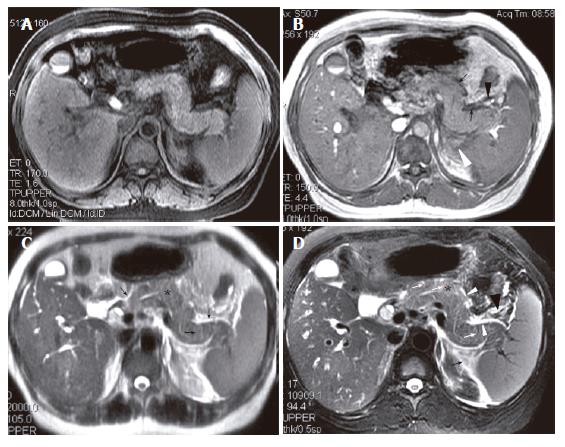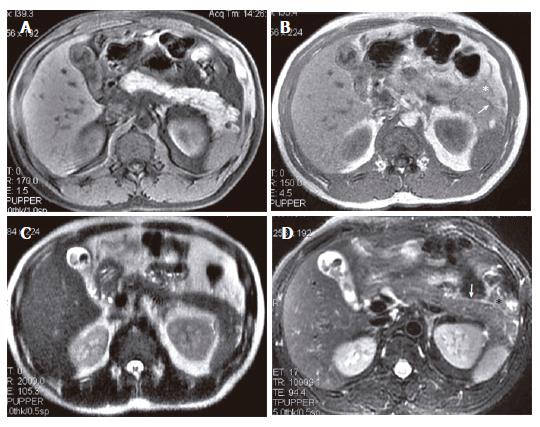Copyright
©2006 Baishideng Publishing Group Co.
World J Gastroenterol. Sep 28, 2006; 12(36): 5859-5865
Published online Sep 28, 2006. doi: 10.3748/wjg.v12.i36.5859
Published online Sep 28, 2006. doi: 10.3748/wjg.v12.i36.5859
Figure 1 A 42-year-old woman with interstitial edematous pancreatitis.
A: SPGR fat-suppressed T1-weighted (TR/TE = 170/1.6 ms) image shows pancreatic signal intensity comparable to that of liver; B: GRE in-phase (TR/TE = 150/4.4 ms) image shows pancreatic fascial plane (arrows) and peripancreatic fat stranding (arrow heads); C: SSFSE T2-weighted (TE = 90 ms) image shows increased pancreatic signal intensity (asterisk). Stranding in the pancreatic fascial plane (large arrow) and peripancreatic fat and thickened pancreatic lobular septum (small arrow) can also be seen; D: R-T T2-weighted (TR/TE = 11 800/93 ms) image shows above findings much better (Asterisk indicates pancreatic parenchyma, white arrows indicate thickened pancreatic lobular septum, white arrow head indicates pancreatic fascial plane, and black arrow and arrow head indicate fat stranding).
Figure 2 A 28-year-old man with IEP.
A: SPGR fat-suppressed T1-weighted (TR/TE = 170/1.6 ms) image shows normal pancreatic signal intensity; B: pancreatic fascial (arrows) and peripancreatic fat (asterisk) stranding can be seen on GRE in-phase (TR/TE, 150/4.4 ms) image; C: SSFSE T2-weighted (TE = 90 ms) image; D: R-T T2-weighted (TR/TE = 12300/98 ms) image. Perivascular fluid (curve arrow) can be seen on latter two sequences. Thickened pancreatic lobular septum (arrow heads) can only be seen on R-T T2-weighted image (D); E: At the level of the head of the pancreas, R-T T2-weighted image (E) shows pancreatic fascial plane (white arrow), right renal fascia plane (white arrow head), fluid surrounding SMV (black arrow), and left anterior pararenal space and lateroconal plane fluid collections (asterisk).
Figure 3 A 45-year-old woman with IEP and cholelithiasis.
(A) SPGR fat-suppressed T1-weighted (TR/TE = 170/1.6 ms) image shows normal pancreatic signal intensity. GRE in-phase (TR/TE = 150/4.4 ms) (B) and SSFSE T2 weighted (TE = 90 ms); (C) images show the pancreatic fascia plane (arrows) and the peripancreatic fat stranding (asterisk), which appear more extensive on R-T T2-weighted (TR/TE = 12 300/98 ms) image (D).
Figure 4 The same patient as in Figure 3.
At the level of the head of the pancreas, left renal fascial plane (arrow) and anterior pararenal space fat stranding (asterisk) present on GRE in-phase (A), SSFSE T2-weighted (B) and R-T T2-weighted (C) images, but they are most prominent on R-T T2-weighted image.
- Citation: Zhang XM, Feng ZS, Zhao QH, Xiao CM, Mitchell DG, Shu J, Zeng NL, Xu XX, Lei JY, Tian XB. Acute interstitial edematous pancreatitis: Findings on non-enhanced MR imaging. World J Gastroenterol 2006; 12(36): 5859-5865
- URL: https://www.wjgnet.com/1007-9327/full/v12/i36/5859.htm
- DOI: https://dx.doi.org/10.3748/wjg.v12.i36.5859












